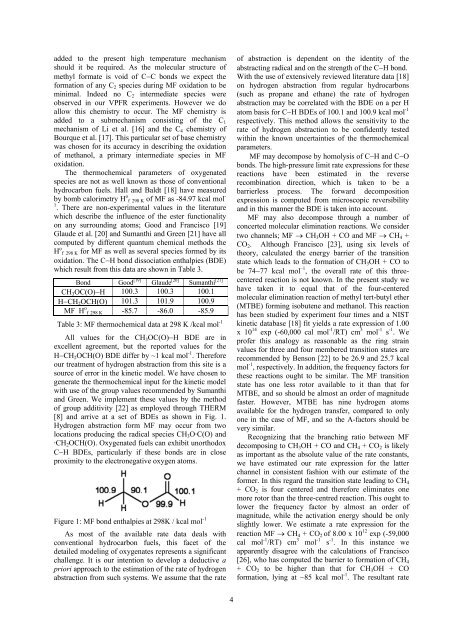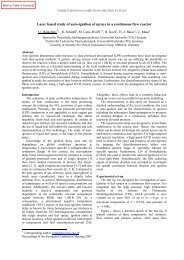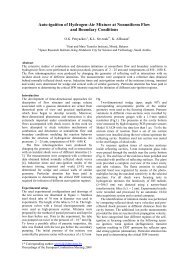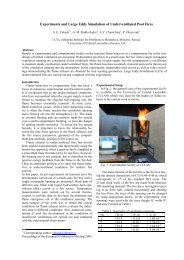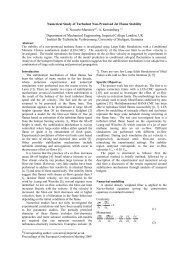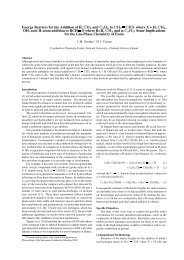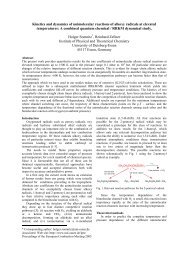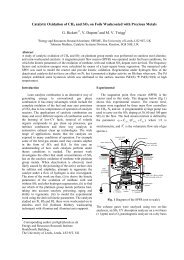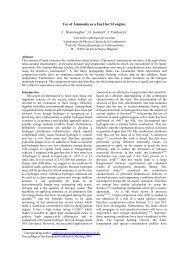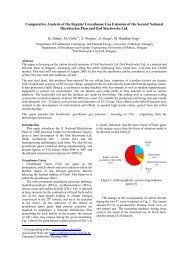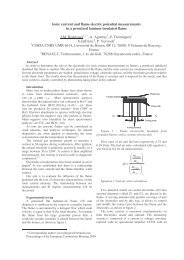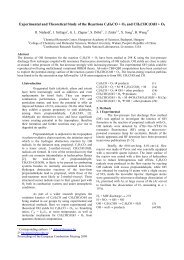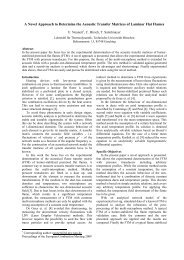An experimental and kinetic modeling study of methyl formate ...
An experimental and kinetic modeling study of methyl formate ...
An experimental and kinetic modeling study of methyl formate ...
You also want an ePaper? Increase the reach of your titles
YUMPU automatically turns print PDFs into web optimized ePapers that Google loves.
added to the present high temperature mechanism<br />
should it be required. As the molecular structure <strong>of</strong><br />
<strong>methyl</strong> <strong>formate</strong> is void <strong>of</strong> C−C bonds we expect the<br />
formation <strong>of</strong> any C2 species during MF oxidation to be<br />
minimal. Indeed no C2 intermediate species were<br />
observed in our VPFR experiments. However we do<br />
allow this chemistry to occur. The MF chemistry is<br />
added to a submechanism consisting <strong>of</strong> the C1<br />
mechanism <strong>of</strong> Li et al. [16] <strong>and</strong> the C4 chemistry <strong>of</strong><br />
Bourque et al. [17]. This particular set <strong>of</strong> base chemistry<br />
was chosen for its accuracy in describing the oxidation<br />
<strong>of</strong> methanol, a primary intermediate species in MF<br />
oxidation.<br />
The thermochemical parameters <strong>of</strong> oxygenated<br />
species are not as well known as those <strong>of</strong> conventional<br />
hydrocarbon fuels. Hall <strong>and</strong> Baldt [18] have measured<br />
by bomb calorimetry H o f 298 K <strong>of</strong> MF as -84.97 kcal mol -<br />
1 . There are non-<strong>experimental</strong> values in the literature<br />
which describe the influence <strong>of</strong> the ester functionality<br />
on any surrounding atoms; Good <strong>and</strong> Francisco [19]<br />
Glaude et al. [20] <strong>and</strong> Sumanthi <strong>and</strong> Green [21] have all<br />
computed by different quantum chemical methods the<br />
H o f 298 K for MF as well as several species formed by its<br />
oxidation. The C−H bond dissociation enthalpies (BDE)<br />
which result from this data are shown in Table 3.<br />
Bond Good [19] Glaude [20] Sumanthi [21]<br />
CH3OC(O)−H 100.3 100.3 100.1<br />
H−CH2OCH(O) 101.3 101.9 100.9<br />
MF H o f 298 K -85.7 -86.0 -85.9<br />
Table 3: MF thermochemical data at 298 K /kcal mol -1<br />
All values for the CH3OC(O)−H BDE are in<br />
excellent agreement, but the reported values for the<br />
H−CH2OCH(O) BDE differ by ~1 kcal mol -1 . Therefore<br />
our treatment <strong>of</strong> hydrogen abstraction from this site is a<br />
source <strong>of</strong> error in the <strong>kinetic</strong> model. We have chosen to<br />
generate the thermochemical input for the <strong>kinetic</strong> model<br />
with use <strong>of</strong> the group values recommended by Sumanthi<br />
<strong>and</strong> Green. We implement these values by the method<br />
<strong>of</strong> group additivity [22] as employed through THERM<br />
[8] <strong>and</strong> arrive at a set <strong>of</strong> BDEs as shown in Fig. 1.<br />
Hydrogen abstraction form MF may occur from two<br />
locations producing the radical species CH3O·C(O) <strong>and</strong><br />
·CH2OCH(O). Oxygenated fuels can exhibit unorthodox<br />
C−H BDEs, particularly if these bonds are in close<br />
proximity to the electronegative oxygen atoms.<br />
Figure 1: MF bond enthalpies at 298K / kcal mol -1<br />
As most <strong>of</strong> the available rate data deals with<br />
conventional hydrocarbon fuels, this facet <strong>of</strong> the<br />
detailed <strong>modeling</strong> <strong>of</strong> oxygenates represents a significant<br />
challenge. It is our intention to develop a deductive a<br />
priori approach to the estimation <strong>of</strong> the rate <strong>of</strong> hydrogen<br />
abstraction from such systems. We assume that the rate<br />
4<br />
<strong>of</strong> abstraction is dependent on the identity <strong>of</strong> the<br />
abstracting radical <strong>and</strong> on the strength <strong>of</strong> the C−H bond.<br />
With the use <strong>of</strong> extensively reviewed literature data [18]<br />
on hydrogen abstraction from regular hydrocarbons<br />
(such as propane <strong>and</strong> ethane) the rate <strong>of</strong> hydrogen<br />
abstraction may be correlated with the BDE on a per H<br />
atom basis for C−H BDEs <strong>of</strong> 100.1 <strong>and</strong> 100.9 kcal mol -1<br />
respectively. This method allows the sensitivity to the<br />
rate <strong>of</strong> hydrogen abstraction to be confidently tested<br />
within the known uncertainties <strong>of</strong> the thermochemical<br />
parameters.<br />
MF may decompose by homolysis <strong>of</strong> C−H <strong>and</strong> C−O<br />
bonds. The high-pressure limit rate expressions for these<br />
reactions have been estimated in the reverse<br />
recombination direction, which is taken to be a<br />
barrierless process. The forward decomposition<br />
expression is computed from microscopic reversibility<br />
<strong>and</strong> in this manner the BDE is taken into account.<br />
MF may also decompose through a number <strong>of</strong><br />
concerted molecular elimination reactions. We consider<br />
two channels; MF → CH3OH + CO <strong>and</strong> MF → CH4 +<br />
CO2. Although Francisco [23], using six levels <strong>of</strong><br />
theory, calculated the energy barrier <strong>of</strong> the transition<br />
state which leads to the formation <strong>of</strong> CH3OH + CO to<br />
be 74−77 kcal mol –1 , the overall rate <strong>of</strong> this threecentered<br />
reaction is not known. In the present <strong>study</strong> we<br />
have taken it to equal that <strong>of</strong> the four-centered<br />
molecular elimination reaction <strong>of</strong> <strong>methyl</strong> tert-butyl ether<br />
(MTBE) forming isobutene <strong>and</strong> methanol. This reaction<br />
has been studied by experiment four times <strong>and</strong> a NIST<br />
<strong>kinetic</strong> database [18] fit yields a rate expression <strong>of</strong> 1.00<br />
x 10 14 exp (-60,000 cal mol -1 /RT) cm 3 mol -1 s -1 . We<br />
pr<strong>of</strong>er this analogy as reasonable as the ring strain<br />
values for three <strong>and</strong> four membered transition states are<br />
recommended by Benson [22] to be 26.9 <strong>and</strong> 25.7 kcal<br />
mol -1 , respectively. In addition, the frequency factors for<br />
these reactions ought to be similar. The MF transition<br />
state has one less rotor available to it than that for<br />
MTBE, <strong>and</strong> so should be almost an order <strong>of</strong> magnitude<br />
faster. However, MTBE has nine hydrogen atoms<br />
available for the hydrogen transfer, compared to only<br />
one in the case <strong>of</strong> MF, <strong>and</strong> so the A-factors should be<br />
very similar.<br />
Recognizing that the branching ratio between MF<br />
decomposing to CH3OH + CO <strong>and</strong> CH4 + CO2 is likely<br />
as important as the absolute value <strong>of</strong> the rate constants,<br />
we have estimated our rate expression for the latter<br />
channel in consistent fashion with our estimate <strong>of</strong> the<br />
former. In this regard the transition state leading to CH4<br />
+ CO2 is four centered <strong>and</strong> therefore eliminates one<br />
more rotor than the three-centred reaction. This ought to<br />
lower the frequency factor by almost an order <strong>of</strong><br />
magnitude, while the activation energy should be only<br />
slightly lower. We estimate a rate expression for the<br />
reaction MF → CH4 + CO2 <strong>of</strong> 8.00 x 10 12 exp (-59,000<br />
cal mol -1 /RT) cm 3 mol -1 s -1 . In this instance we<br />
apparently disagree with the calculations <strong>of</strong> Francisco<br />
[26], who has computed the barrier to formation <strong>of</strong> CH4<br />
+ CO2 to be higher than that for CH3OH + CO<br />
formation, lying at ~85 kcal mol -1 . The resultant rate


